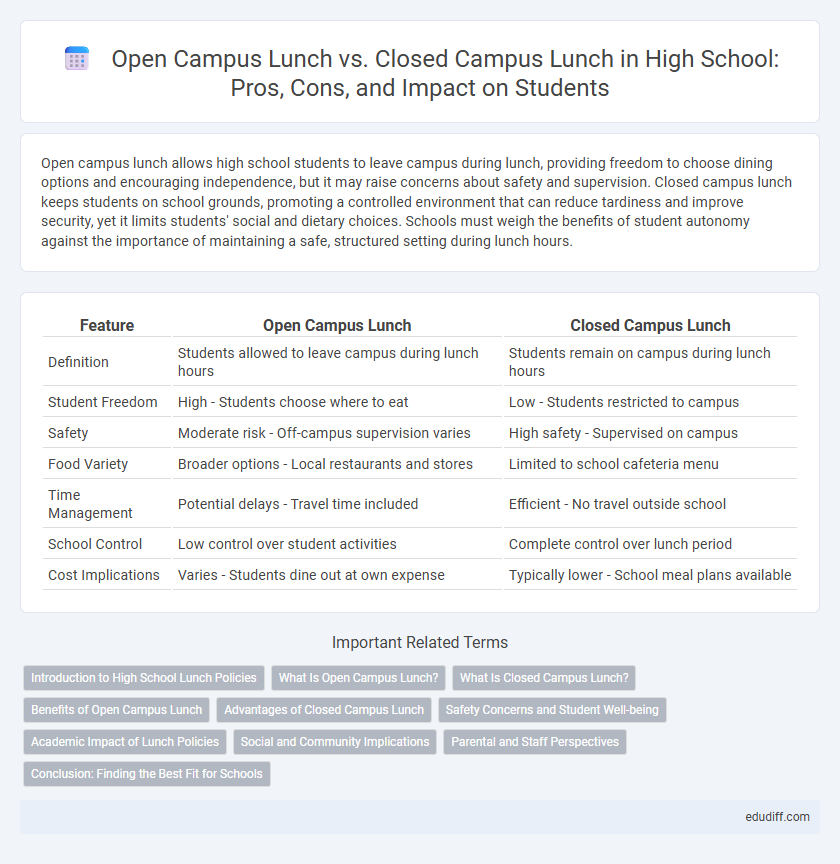Open campus lunch allows high school students to leave campus during lunch, providing freedom to choose dining options and encouraging independence, but it may raise concerns about safety and supervision. Closed campus lunch keeps students on school grounds, promoting a controlled environment that can reduce tardiness and improve security, yet it limits students' social and dietary choices. Schools must weigh the benefits of student autonomy against the importance of maintaining a safe, structured setting during lunch hours.
Table of Comparison
| Feature | Open Campus Lunch | Closed Campus Lunch |
|---|---|---|
| Definition | Students allowed to leave campus during lunch hours | Students remain on campus during lunch hours |
| Student Freedom | High - Students choose where to eat | Low - Students restricted to campus |
| Safety | Moderate risk - Off-campus supervision varies | High safety - Supervised on campus |
| Food Variety | Broader options - Local restaurants and stores | Limited to school cafeteria menu |
| Time Management | Potential delays - Travel time included | Efficient - No travel outside school |
| School Control | Low control over student activities | Complete control over lunch period |
| Cost Implications | Varies - Students dine out at own expense | Typically lower - School meal plans available |
Introduction to High School Lunch Policies
High school lunch policies shape student access and behavior during meal times, with open campus lunch allowing students to leave campus for lunch and closed campus lunch requiring them to remain on school grounds. Open campus lunch fosters greater independence and access to diverse food options, while closed campus lunch prioritizes student safety and minimizes tardiness. Both policies influence social dynamics, nutrition, and school supervision, impacting overall student well-being.
What Is Open Campus Lunch?
Open campus lunch allows high school students to leave school grounds during lunch periods, giving them the freedom to visit nearby restaurants or go home. This policy provides greater autonomy and access to diverse dining options, promoting independence and real-world decision-making skills. School districts often implement open campus lunch to manage overcrowding in cafeterias and enhance student satisfaction.
What Is Closed Campus Lunch?
Closed campus lunch policies require students to remain on school grounds during lunch hours, preventing them from leaving the campus. This approach enhances student safety by limiting exposure to external risks and ensures that students have access to nutritious meals provided by the school cafeteria. Schools implementing closed campus lunch often see improved attendance and reduced tardiness in afternoon classes.
Benefits of Open Campus Lunch
Open campus lunch policies provide high school students with greater autonomy, allowing them to choose nutritious meals that suit their dietary preferences and cultural tastes outside the cafeteria. This flexibility can promote responsible decision-making and time management skills as students navigate local dining options during lunch breaks. Access to diverse food choices in the community supports better nutritional balance compared to restricted, often repetitive school lunch menus.
Advantages of Closed Campus Lunch
Closed campus lunch policies enhance student safety by reducing the likelihood of accidents and altercations off school grounds. These policies promote healthier eating habits as meals are provided on campus with nutritional guidelines, limiting access to fast food and unhealthy snacks. Moreover, closed campuses encourage students to socialize and build community within a supervised environment, fostering a sense of school spirit and engagement.
Safety Concerns and Student Well-being
Closed campus lunch policies enhance student safety by reducing exposure to traffic accidents and off-campus conflicts, ensuring a controlled environment. Restricting lunch to campus helps staff monitor student well-being more effectively, addressing health issues and promoting balanced nutrition. Open campus lunches offer freedom but increase risks related to unsupervised activities and potential exposure to unsafe environments.
Academic Impact of Lunch Policies
Open campus lunch policies grant students freedom during midday breaks, potentially distracting from academic focus due to off-campus social activities and extended lunch periods. Closed campus lunch policies ensure students remain on school grounds, fostering structured environments that can increase lunchtime supervision and reduce tardiness to afternoon classes. Studies indicate that closed campus lunches correlate with improved attendance and higher academic performance by minimizing off-campus disruptions and promoting consistent eating schedules.
Social and Community Implications
Open campus lunch policies promote greater social interaction and community engagement among high school students by allowing them to explore local dining options and connect with peers outside the school environment. Closed campus lunches create a more controlled setting, fostering a sense of school community by encouraging students to stay on campus and participate in school-based social activities. Both approaches significantly impact students' social development and sense of belonging within their educational community.
Parental and Staff Perspectives
Parents often favor closed campus lunch policies for the increased safety and supervision they provide, reducing concerns about student exposure to external risks. Staff members appreciate closed campuses as they help maintain discipline and ensure students remain on school grounds, minimizing tardiness and promoting healthier eating habits. In contrast, proponents of open campus lunches argue that they foster student independence and allow access to diverse meal options, highlighting the need for balanced perspectives from both parents and staff.
Conclusion: Finding the Best Fit for Schools
Open campus lunch policies offer students greater freedom and opportunities for socialization, which can enhance their overall high school experience, while closed campus lunches ensure better supervision and student safety on school grounds. Schools must evaluate factors such as student maturity, local traffic conditions, and community resources to determine the best fit for their unique environment. Balancing these considerations helps administrators create a lunch policy that supports student development and school safety.
Open campus lunch vs Closed campus lunch Infographic

 edudiff.com
edudiff.com